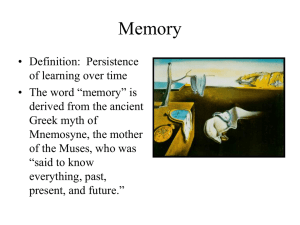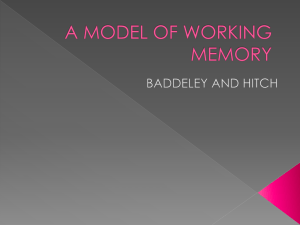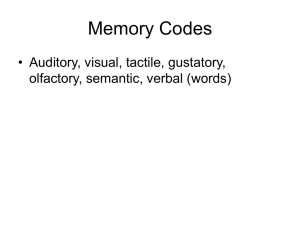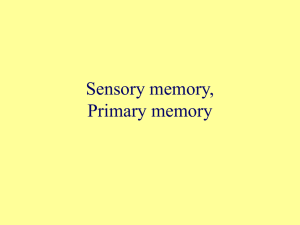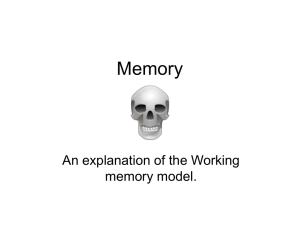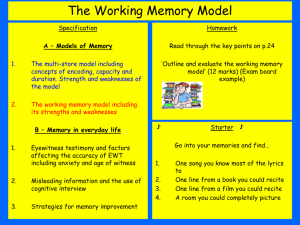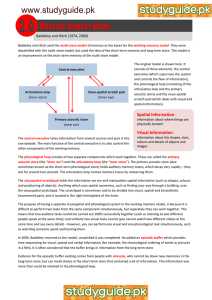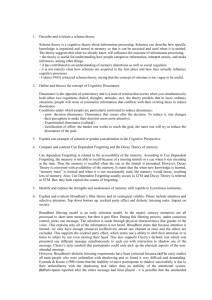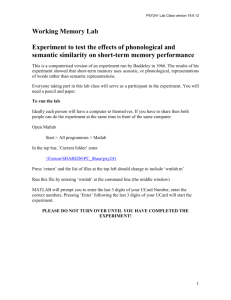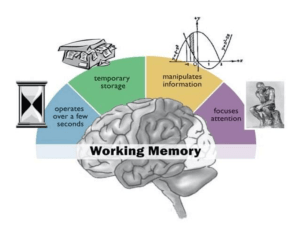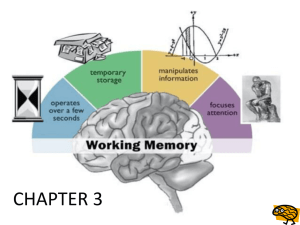The Architecture of Human Memory
advertisement
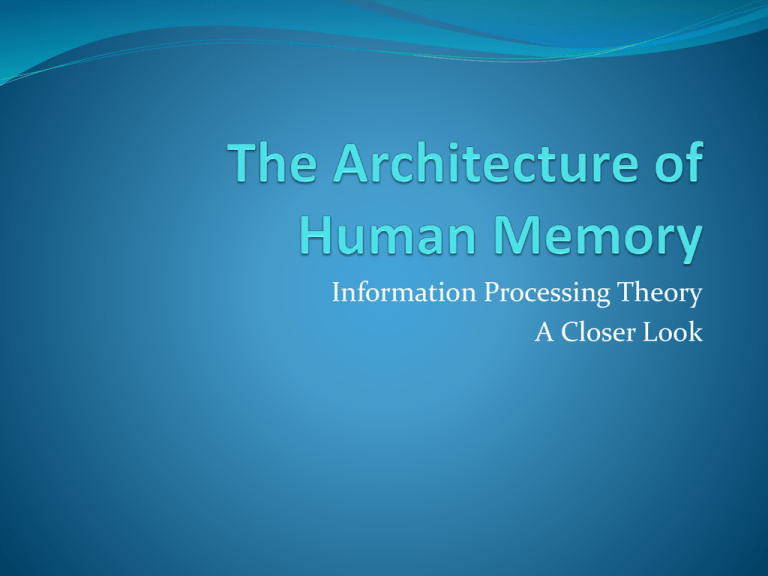
Information Processing Theory A Closer Look Epistemic Heritage To The Model Memory research dates back to 1885 with Hermann Ebbinhaus who looked at memory in terms of nonsense symbols. In the 1950s cognitive scientists began creating models that acknowledge the stages of acquisition storage and retrieval. The increasing influence of computers were clearly reflected in these models that came to be known as Information Processing Models One of the most influential models was the modal model proposed by Atkinson and Shiffrin in 1968. Modal Model Long Term Memory retrieval Sensory memory Declarative Knowledge Short term Memory Procedural Knowledge encoding Rehearsal Conditional Knowledge Criticisms of the Modal Model Proposes three separate structures in memory ,short term, long term and sensory. Assumes that information only flows one way in a linear fashion. It is believed that information in long term memory influences short term memory and information is processed concurrently in short term and long term memory Does not correspond to any one area of the brain. Description of Sensory Memory Sensory memory-”is a system that briefly holds stimuli in sensory registers so that perceptual analyses can occur before the information is lost”. Two Types of Sensory Registers Visual registers are very limited. visual memory can only process 7 to 9 pieces of information at any given time. Information is only available briefly 0.5 seconds Auditory Registers are limited. Auditory registers can only process 5 to 7 pieces of information. Auditory information can only be stored for up to 4 seconds before the information becomes unavailable. Steps in sensory memory process Perception enables us to identify incoming perceptual stimuli and direct attention to them. Pattern recognition enables us to associate perceptual information with a recognizable pattern, then it is forwarded to short term memory. Description of Short Term Memory Short term memory is the place where information is stored for meaning. It has limited capacity and duration. The current name for short term memory is working memory. It can only hold 7 chunks plus or minus two (Miller). The duration is not limited by time so much but by interference and capacity overload.– but generally restricted to 30 seconds. Postulation about short term and sensory memory Memory systems are functionally separate Attention is limited Process are controlled and automatic Automatic task are much easier to perform and require much fewer cognitive resources (e.g. strategies) Meaning is constructed based on context and prior knowledge Working Memory Baddeley replaced the unitary short term store with a working memory system Central executive, which is assumed to be an attentioncontrolling system. Visuospatial sketch pad manipulates visual images Phonological loop stores and rehearses speech-based information and is necessary for the acquisition of both native and second-language vocabulary. Executive Visuospatial Sketchpad Phonological Loop Long Term Memory It is referred to as a permanent storehouse for information. Long term memory is capable of storing unlimited amounts of information. Anything that you want to remember for a long period of time must be transferred for short term to long term memory. Baddeley’s Original Model of Working Memory Visuospatial Sketchpad Central Executive Phonological Loop Baddeley’s Revised Model of Working Memory 2001 Baddeley’s Article Central Executive Visuospatial Sketchpad Visual Semantics Episodic Buffer Episodic LTM Phonological loop Language The Phonological Loop Broken into two components a phonological store and an articulatory rehearsal system. It is assumed to decay over time unless refreshed by rehearsal, It is dependent on the second component the articulatory loop. Phonological Store Similarity effect-the immediate recall of items that sound similar (B ,V, G T, C,) is poorer than dissimilar items (F ,K ,Y, W, M,R ,) Similarity of meaning has little effect in the standard immediate recall paradigm The opposite is true for the learning of multitrial long term learning of ten items, it solely depends on semantic rather than acoustic Articulatory Rehearsal It was proposed to give an account of the immediate word length effect, whereby the is the immediate serial recall is a direct function of the length of items being retained (Baddeley, Thomson& Buchanan) An example is a sequence such as sum, pay, wit, bar, hop is much more likely to be recalled correctly than helicopter, university, television, alligator, opportunity. This reflects the slower rehearsal of longer words that allows greater forgetting. The Visuospatial Sketchpad Assumed to capable of temporarily maintaining and manipulating visouspatial information Forms an interface between visual and spatial information accessed either by senses or long term memory Takes up one slot in working memory. Processed simultaneously, rather than sequentially. Drives retreival– conjoint retention model. The Central Executive In charge of focusing attention Also in charge of dividing attention Switching attention also happens here Forms an interface between long term memory and subsystems Responsible for metacognitive monitoring. Episodic Buffer This is assumed to be capable of combining information from LTM with that from the slave systems. Dedicated to linking information across domains to form integrated units of visual, spatial, and verbal information (e.g., the memory of a story or a movie scene, a 2D graphic). Responsible for metacognitive strategy deployment. Summary Baddeley replaced the unitary short-term store with a working memory system consisting of three components: an attention-like central executive, a phonological loop holding speech-based information, and a visuo-spatial sketchpad specialized for spatial and visual coding. This working memory system is of relevance to non- memory activities such as comprehension and verbal reasoning. The phonological loop and visuo-spatial sketchpad have both been sub-divided into twocomponent systems, one component for storage and one for processing. The central executive fulfils several functions. Many of the characteristics of the central executive remain unclear.
